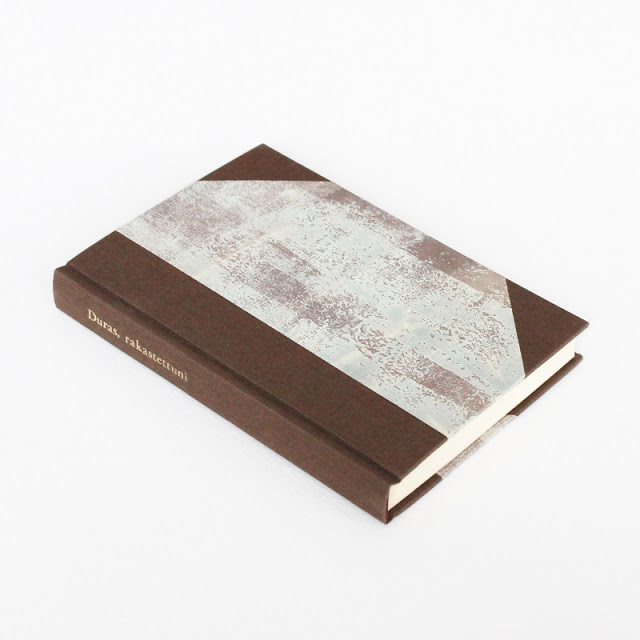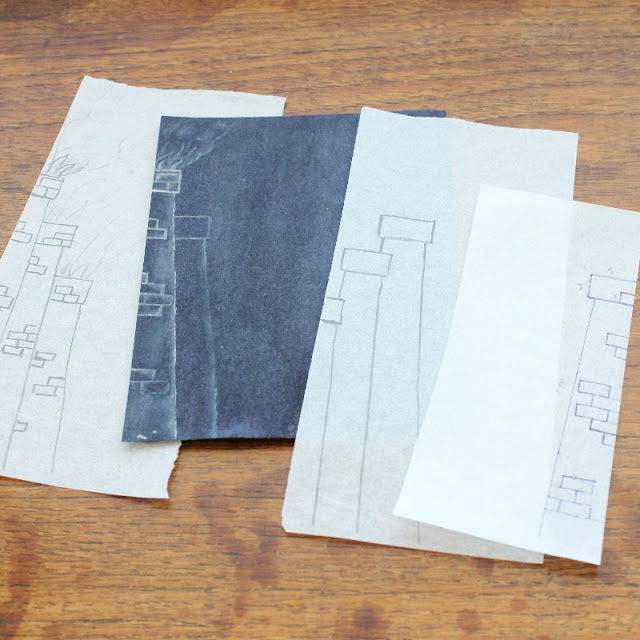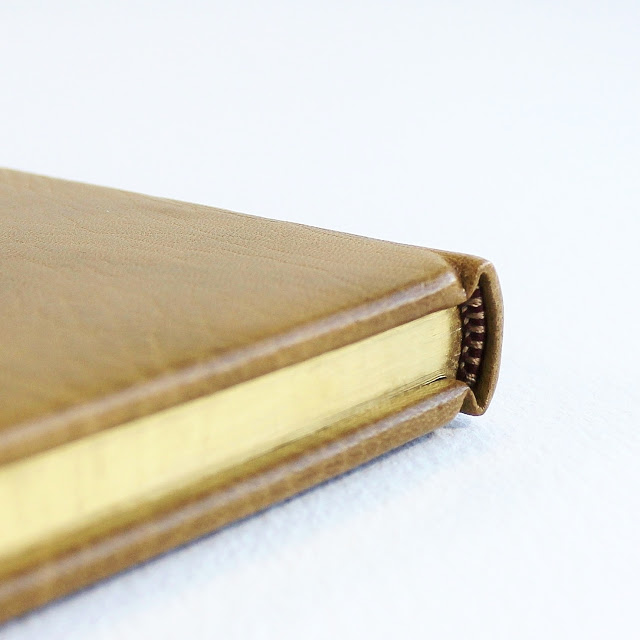This large (33x26cm/13"x10.2") photo album was actually the beginning of something much bigger. After I opened my Etsy shop in the autumn of 2007, my biggest sellers for a few years were unique stenciled notebooks with linen covers (and then I just got bored with the technique and with the other bookbinders on Etsy suddenly stenciling their suddenly linen books, and I then moved on to other techniques and designs). This book was my first one combining those two things. The leaf design is mirrored on the back cover, creating a family tree type of theme for the photo album.
The structure of studies and the qualifications for any official bookbinder's occupational degree vary a lot from country to country, and even the terminology is a bit of a mess. When I was studying (in 2004-2006) there were three different bookbinder programs: artisan, apprenticeship, and master, but I think the most official English translation of my master's degree at the moment would be that I hold a specialist qualification for bookbinders. Sounds so lame I'm going to stick with the oldschool title. I've also let myself be informed that at the moment it looks like there's no occupational training in Finland for bookbinders of any level anymore, which is sad, but also understandable. We already had a hard time gathering up the required nine students for the course in 2006, and there's been a few courses (apprenticeship, maybe no master) after ours.
Anyway, I took a pretty unconventional study path and moved directly from my apprenticeship program to the master program and got the degrees back to back, graduating as a master bookbinder only 2½ years after beginning my full time studies. I know at least in Germany this wouldn't be possible, and I guess maturing a bit between the degrees is a relevant part of the plan elsewhere, too. The master program usually takes two years, but we had two years' worth of studies packed into one (for budget reasons, I assume), so that year was no picnic. The format for studies was the same as before (lots of visiting teachers and intensive 1-2 week courses on various subjects - we even got to make our own leather paring knives and some metal bonefolders!), just a lot more demanding.
Honestly, that year was one of the worst (if not the worst) in my life - bookbinding was still awesome, but I just had the most horrible time tolerating human contact at the time, and I couldn't have gotten away soon enough. In the end, only 2 of our group of 9 passed the exam on the first try, and I'm not actually sure if the other seven ever tried to retake it (I've told you before - I'm the worst at staying in touch!). It wasn't an easy exam and many boxes needed to be ticked before passing it.
The pre-made books for the exam were to be: full+half leather bindings, full+half cloth bindings, an album, one of the books had to feature a hand gilt real gold edge, 4 of the books with titles (I think at least one hand gilt in real gold), and decoration+hand gilding on the full leather binding. There was also a theory exam, an interview, a written project (I have no recollection what I did mine about and I didn't come across it during my study material excavation, so I can't self-evaluate how well or bad I did in retrospect), some business stuff I'm eternally surprised I passed, and we had to round and back a book + sew endbands to it some time during the exam days for the evaluation of the master bookbinders in charge of our futures.
For this series of posts I went through folders and folders of course handouts, unreadable notes, and sketches for past projects. These sketches for the binding of Jorge Semprún's Suuri matka (Le grand voyage/The Long Voyage - the author's name in the title is written as it is printed on the title page, hence the missing acute) emerged from that lot. I had a much more blue colour scheme in mind at first, and I tried some wax resistance techniques for the paper, too, but I ended up going with straightforward painting combined with hand gilding on leather.
I still have mountains of materials from my school days I'd like to share with you some day - decorating plaquettes, other technique samplers and book models. All that is hidden under the bed, in boxes, inaccessible until I use up at least 5-10 kilograms of paper that's sitting atop those boxes. At that stage I might be able to lift the rest of that pile of paper off with the help of V. Note to self: don't go buying 500 massive sheets of paper without thinking at what pace you use it and how much easier it would be to work with slightly smaller sheets....
Back-pared leather onlays and hand gilding. Donna Quijote ja muita kaupunkilaisia. Muotokuva (translated as Doña Quixote and other citizens) by Leena Krohn
My edge gilding skills were never top notch, but I passed the exam nonetheless - luckily the photo doesn't really do justice to my gold edge anyway, so it's up to you to imagine how good or bad I really was. No, seriously, it's alright, it's just duller than I'd like it to be. Edge gilding was perhaps the one thing that I now feel sad about not getting to practice enough at school. My press at home isn't heavy duty enough for getting good gold edges, so I've never gotten round to acquiring the other necessary equipment either.
I'm a serious tool hoarder, so it's a minor wonder I have virtually no gilding equipment - just a few simple lines I made myself on the tool making course, but I haven't ever used them after graduating. Fine binding in general just slowly fell off the list of things I do, with the exception of participating in some bookbinding competitions, probably mainly for personal budget reasons (it gets really expensive quickly, unless you have/want actual customers willing to pay for your work). If fine binding ever does a comeback to my life, I have a lot of practicing to do again. Luckily the skills you hone daily, or at least weekly, for some years, tend to come back quickly when you need them again. I know I can still do a mean headcap.












